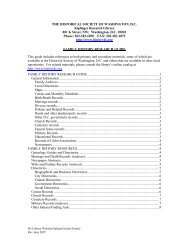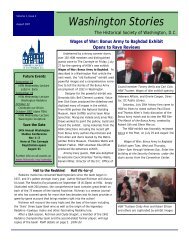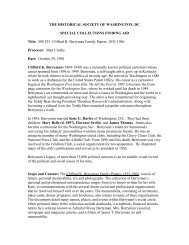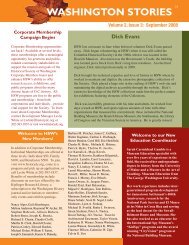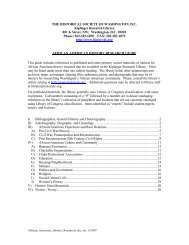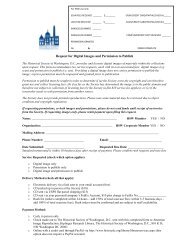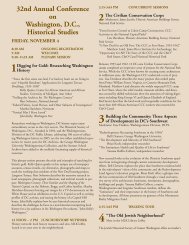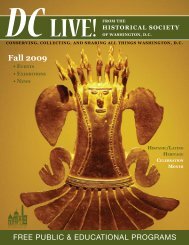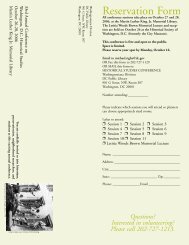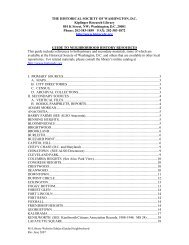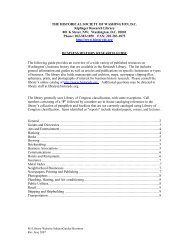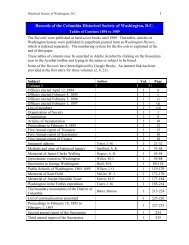Building History Resources - The Historical Society of Washington, DC
Building History Resources - The Historical Society of Washington, DC
Building History Resources - The Historical Society of Washington, DC
You also want an ePaper? Increase the reach of your titles
YUMPU automatically turns print PDFs into web optimized ePapers that Google loves.
2<br />
GENERAL INFORMATION ON BUILDING HISTORY<br />
A) BUILDING AND NEIGHBORHOOD CLUES<br />
Note architectural details, building materials, clues to current and previous use, possible<br />
alterations, relationship to surrounding buildings in the neighborhood, etc. Review published<br />
materials on architectural styles and local neighborhood history to place building within its<br />
historical context. If possible, consult family records and photographs and interview current and<br />
previous owners. SEE HSW’s Neighborhood <strong>History</strong> Research Guide.<br />
B) REAL ESTATE ATLASES<br />
Identify street address, square and lot number/s, and subdivision name (if applicable). Depending<br />
on location <strong>of</strong> property, any or all <strong>of</strong> these elements may have varied over time. Reviewing real<br />
estate atlases chronologically can help determine approximate date <strong>of</strong> building construction and<br />
track neighborhood development. Record all transitions in lot /square numbers and street<br />
addresses (previous numbers and street names are generally listed in parentheses). <strong>The</strong> following<br />
maps show the location <strong>of</strong> buildings (micr<strong>of</strong>ilm copies at <strong>Washington</strong>iana, <strong>DC</strong>PL and Library <strong>of</strong><br />
Congress):<br />
Boschke maps, 1857, 1861 (1857 shows City <strong>of</strong> <strong>Washington</strong> only, including building footprints;<br />
1861 shows the entire District; location <strong>of</strong> buildings included, but not as detailed as the 1857<br />
map)<br />
Faehtz & Pratt atlas, 1873-1874 (City <strong>of</strong> <strong>Washington</strong> only; 4 volumes arranged by square<br />
number; tax assessments describe property improvements; accompanying plat maps do not show<br />
buildings)<br />
Hopkins atlas, 1878 (includes the entire metropolitan area and Prince George’s County; published<br />
in small volume, G1275 .H59 1878)<br />
Hopkins real estate atlases, 1887-1896 (issued periodically; after 1887, arranged by location)<br />
Baist real estate atlases, 1903-1968 (issued periodically; arranged in volumes by location)<br />
Sanborn insurance maps, 1888-present (Property amendments were pasted on over time)<br />
NOTE: <strong>The</strong> Surveyor’s Office, 614 H Street, N.W., holds files with varied information on<br />
subdivisions and individual properties; the staff maintains several card indexes.<br />
C) BUILDING PERMITS<br />
From February 7, 1877, building permits were required for all new construction. Permits provide<br />
information on date <strong>of</strong> construction, architect, builder, owner, materials, dimensions, cost and use<br />
<strong>of</strong> building. Permits were also issued for alterations, additions, and demolition.<br />
<strong>Building</strong> permit indexes, 1877-1958 – <strong>The</strong>se indexes are on micr<strong>of</strong>ilm and may be consulted at<br />
National Archives or <strong>Washington</strong>iana, <strong>DC</strong>PL (not all years may be available at <strong>Washington</strong>iana;<br />
check with their reference staff.)<br />
Check all <strong>of</strong> the following indexes that are applicable to the property you are researching: Square<br />
number, 1877-1928; Subdivision, 1877-1908; and Street Address, 1928-1958. Record permit<br />
number/s, abbreviations and dates. Each permit number corresponds to a specific year.<br />
M:\Library Website/SubjectGuides/<strong>Building</strong><br />
Rev June 2007



